alternator Seat Leon 5D 2011 Owner's manual
[x] Cancel search | Manufacturer: SEAT, Model Year: 2011, Model line: Leon 5D, Model: Seat Leon 5D 2011Pages: 302, PDF Size: 4.17 MB
Page 80 of 302
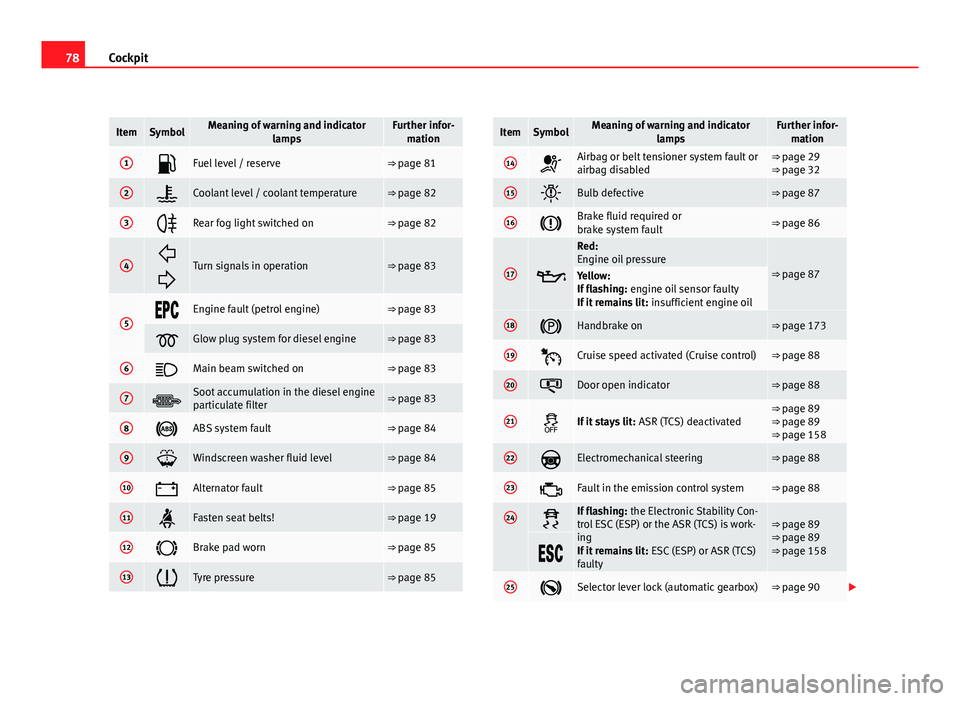
78Cockpit
ItemSymbolMeaning of warning and indicator
lampsFurther infor-mation
1’āāFuel level / reserveŌćÆŌĆŖpage 81
2’é┐Coolant level / coolant temperatureŌćÆŌĆŖpage 82
3’ƬRear fog light switched onŌćÆŌĆŖpage 82
4’Ć¼
’ĆŁTurn signals in operationŌćÆŌĆŖpage 83
5’üģ’üÉ’üāEngine fault (petrol engine)ŌćÆŌĆŖpage 83
’üżGlow plug system for diesel engineŌćÆŌĆŖpage 83
6’ĆżMain beam switched onŌćÆŌĆŖpage 83
7’āĘSoot accumulation in the diesel engine
particulate filterŌćÆŌĆŖpage 83
8’ü¬ABS system faultŌćÆŌĆŖpage 84
9’ü╣Windscreen washer fluid levelŌćÆŌĆŖpage 84
10’ü”Alternator faultŌćÆŌĆŖpage 85
11’é¬Fasten seat belts!ŌćÆŌĆŖpage 19
12’ü®Brake pad wornŌćÆŌĆŖpage 85
13’āćTyre pressureŌćÆŌĆŖpage 85
ItemSymbolMeaning of warning and indicator lampsFurther infor-mation
14’ü┤Airbag or belt tensioner system fault or
airbag disabledŌćÆŌĆŖpage 29
ŌćÆŌĆŖpage 32
15’ĆĮBulb defectiveŌćÆŌĆŖpage 87
16’ü©Brake fluid required or
brake system faultŌćÆŌĆŖpage 86
17’üź
Red:
Engine oil pressure
ŌćÆŌĆŖpage 87Yellow:
If flashing: engine oil sensor faulty
If it remains lit: insufficient engine oil
18’ü¦Handbrake onŌćÆŌĆŖpage 173
19’üØCruise speed activated (Cruise control)ŌćÆŌĆŖpage 88
20’é┤Door open indicatorŌćÆŌĆŖpage 88
21’é½If it stays lit: ASR (TCS) deactivatedŌćÆŌĆŖpage 89
ŌćÆŌĆŖpage 89
ŌćÆŌĆŖpage 158
22’ü║Electromechanical steeringŌćÆŌĆŖpage 88
23’üĖFault in the emission control systemŌćÆŌĆŖpage 88
24’āČIf flashing: the Electronic Stability Con-
trol ESC (ESP) or the ASR (TCS) is work-
ing
If it remains lit: ESC (ESP) or ASR (TCS)
faultyŌćÆŌĆŖpage 89
ŌćÆŌĆŖpage 89
ŌćÆŌĆŖpage 158
’üģ’üō’üā
25’ü½Selector lever lock (automatic gearbox)ŌćÆŌĆŖpage 90 ’éŻ
Page 87 of 302
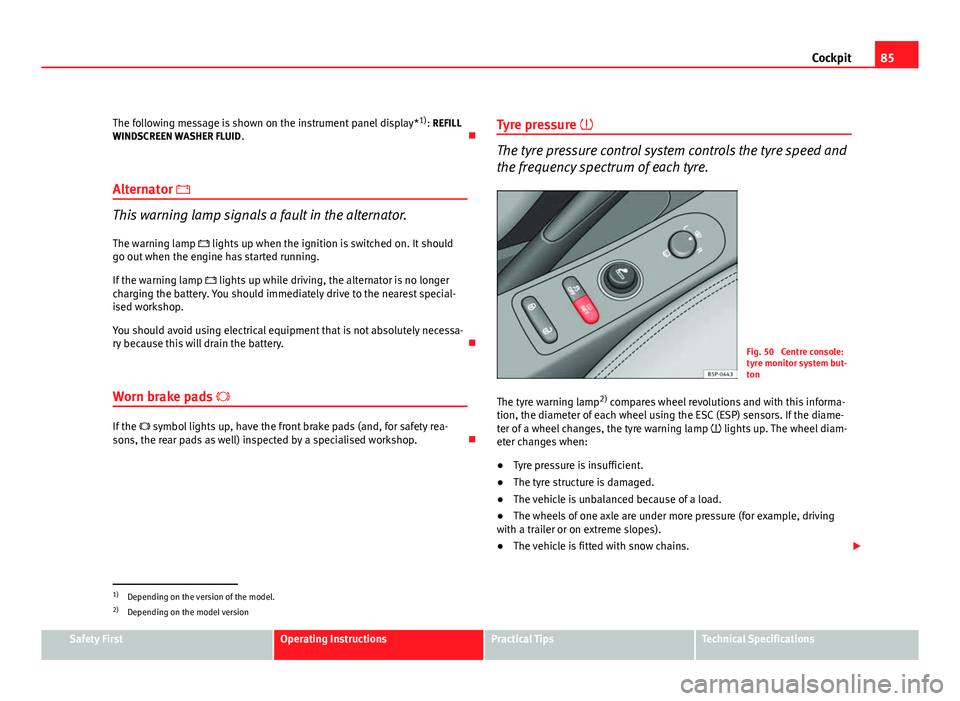
85
Cockpit
The following message is shown on the instrument panel display* 1)
: REFILL
WINDSCREEN WASHER FLUID . ’āÉ
Alternator ’ü”
This warning lamp signals a fault in the alternator.
The warning lamp ’ü” lights up when the ignition is switched on. It should
go out when the engine has started running.
If the warning lamp ’ü” lights up while driving, the alternator is no longer
charging the battery. You should immediately drive to the nearest special-
ised workshop.
You should avoid using electrical equipment that is not absolutely necessa-
ry because this will drain the battery. ’āÉ
Worn brake pads ’ü®
If the ’ü® symbol lights up, have the front brake pads (and, for safety rea-
sons, the rear pads as well) inspected by a specialised workshop. ’āÉTyre pressure ’āć
The tyre pressure control system controls the tyre speed and
the frequency spectrum of each tyre.
Fig. 50 Centre console:
tyre monitor system but-
ton
The tyre warning lamp 2)
compares wheel revolutions and with this informa-
tion, the diameter of each wheel using the ESC (ESP) sensors. If the diame-
ter of a wheel changes, the tyre warning lamp ’āć lights up. The wheel diam-
eter changes when:
ŌŚÅ Tyre pressure is insufficient.
ŌŚÅ The tyre structure is damaged.
ŌŚÅ The vehicle is unbalanced because of a load.
ŌŚÅ The wheels of one axle are under more pressure (for example, driving
with a trailer or on extreme slopes).
ŌŚÅ The vehicle is fitted with snow chains. ’éŻ
1)
Depending on the version of the model.
2) Depending on the model version
Safety FirstOperating InstructionsPractical TipsTechnical Specifications
Page 167 of 302

165
Driving
ŌŚÅ If in an increase in airflow 10
ŌćÆŌĆŖfig. 113 is required for more than three
presses.
ŌŚÅ Temperature setting HI or LO is selected.
ŌŚÅ The engine coolant temperature is insufficient.
ŌŚÅ The alternator is faulty, for example the V-belt has ruptured.
ŌŚÅ If any of the conditions described in the previous section are not fulfil-
led.
WARNING
Never allow the vehicle to move with the engine off for any reason. You
could lose control of your vehicle. This could cause an accident and seri-
ous injury.
ŌŚÅ The brake servo does not work with the engine off. You need more
force to stop the vehicle.
ŌŚÅ Power steering does not work when the engine is not running. That is
why it is much more difficult to turn the steering wheel.
ŌŚÅ Disconnect the Start-Stop system when driving through water (ford-
ing streams, etc.).
Note
ŌŚÅ For vehicles with the Start-Stop function and a manual gearbox, when
the engine is started, the clutch must be pressed.
ŌŚÅ When the conditions for the Start-Stop function are not fulfilled, the in-
strument panel displays the Start-Stop indicator dimmed.
ŌŚÅ If the steering wheel is turned more than 270┬░, it will not be possible to
start the vehicle again. To start the vehicle, straighten the steering wheel so
that it is turned less than 270┬░. ’āÉActivating and deactivating the Start-Stop function
Fig. 119 The Start-Stop
function button.
Every time the ignition is switched on, the Start-Stop function is au-
tomatically switched on.
Manually deactivating the Start-Stop function
ŌĆō Press the A
ŌćÆŌĆŖfig. 119 located in the centre console. When the
Start-Stop function is deactivated, the pushbutton indicator
lights.
ŌĆō If the Start-Stop function is operating then the engine starts im-
mediately.
Switching the Start-Stop function on manually
ŌĆō Press the A
ŌćÆŌĆŖfig. 119 located in the centre console. The indi-
cator on the button will go out. ’āÉ
Safety FirstOperating InstructionsPractical TipsTechnical Specifications
Page 195 of 302
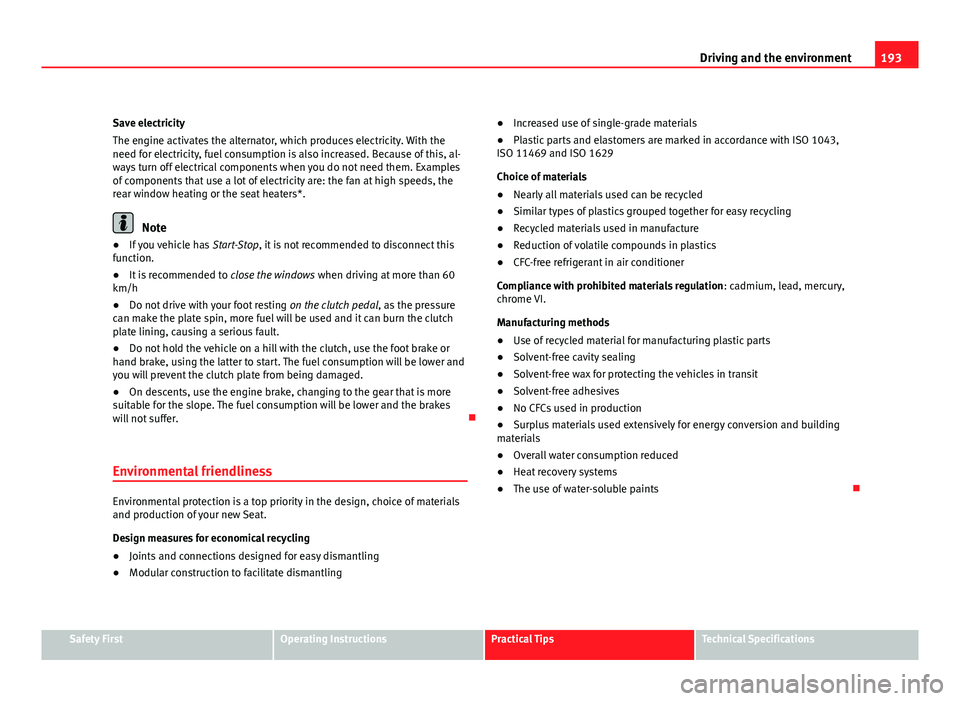
193
Driving and the environment
Save electricity
The engine activates the alternator, which produces electricity. With the
need for electricity, fuel consumption is also increased. Because of this, al-
ways turn off electrical components when you do not need them. Examples
of components that use a lot of electricity are: the fan at high speeds, the
rear window heating or the seat heaters*.
Note
ŌŚÅ If you vehicle has Start-Stop, it is not recommended to disconnect this
function.
ŌŚÅ It is recommended to close the windows when driving at more than 60
km/h
ŌŚÅ Do not drive with your foot resting on the clutch pedal, as the pressure
can make the plate spin, more fuel will be used and it can burn the clutch
plate lining, causing a serious fault.
ŌŚÅ Do not hold the vehicle on a hill with the clutch, use the foot brake or
hand brake, using the latter to start. The fuel consumption will be lower and
you will prevent the clutch plate from being damaged.
ŌŚÅ On descents, use the engine brake, changing to the gear that is more
suitable for the slope. The fuel consumption will be lower and the brakes
will not suffer. ’āÉ
Environmental friendliness
Environmental protection is a top priority in the design, choice of materials
and production of your new Seat.
Design measures for economical recycling
ŌŚÅ Joints and connections designed for easy dismantling
ŌŚÅ Modular construction to facilitate dismantling ŌŚÅ
Increased use of single-grade materials
ŌŚÅ Plastic parts and elastomers are marked in accordance with ISO 1043,
ISO 11469 and ISO 1629
Choice of materials
ŌŚÅ Nearly all materials used can be recycled
ŌŚÅ Similar types of plastics grouped together for easy recycling
ŌŚÅ Recycled materials used in manufacture
ŌŚÅ Reduction of volatile compounds in plastics
ŌŚÅ CFC-free refrigerant in air conditioner
Compliance with prohibited materials regulation : cadmium, lead, mercury,
chrome VI.
Manufacturing methods
ŌŚÅ Use of recycled material for manufacturing plastic parts
ŌŚÅ Solvent-free cavity sealing
ŌŚÅ Solvent-free wax for protecting the vehicles in transit
ŌŚÅ Solvent-free adhesives
ŌŚÅ No CFCs used in production
ŌŚÅ Surplus materials used extensively for energy conversion and building
materials
ŌŚÅ Overall water consumption reduced
ŌŚÅ Heat recovery systems
ŌŚÅ The use of water-soluble paints ’āÉ
Safety FirstOperating InstructionsPractical TipsTechnical Specifications
Page 220 of 302
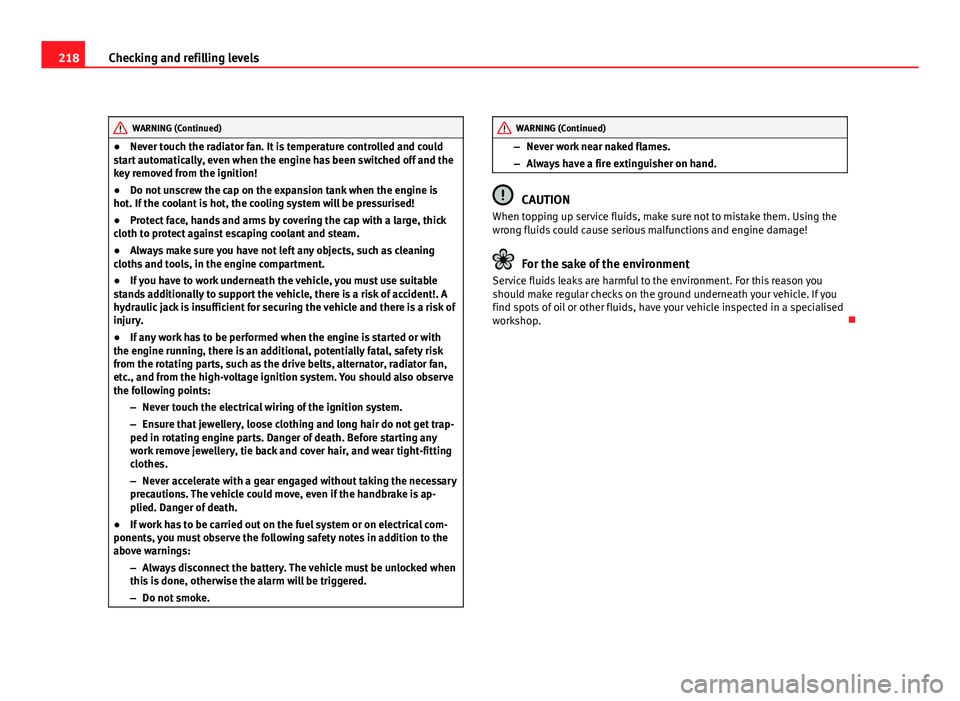
218Checking and refilling levels
WARNING (Continued)
ŌŚÅ Never touch the radiator fan. It is temperature controlled and could
start automatically, even when the engine has been switched off and the
key removed from the ignition!
ŌŚÅ Do not unscrew the cap on the expansion tank when the engine is
hot. If the coolant is hot, the cooling system will be pressurised!
ŌŚÅ Protect face, hands and arms by covering the cap with a large, thick
cloth to protect against escaping coolant and steam.
ŌŚÅ Always make sure you have not left any objects, such as cleaning
cloths and tools, in the engine compartment.
ŌŚÅ If you have to work underneath the vehicle, you must use suitable
stands additionally to support the vehicle, there is a risk of accident!. A
hydraulic jack is insufficient for securing the vehicle and there is a risk of
injury.
ŌŚÅ If any work has to be performed when the engine is started or with
the engine running, there is an additional, potentially fatal, safety risk
from the rotating parts, such as the drive belts, alternator, radiator fan,
etc., and from the high-voltage ignition system. You should also observe
the following points:
ŌĆōNever touch the electrical wiring of the ignition system.
ŌĆō Ensure that jewellery, loose clothing and long hair do not get trap-
ped in rotating engine parts. Danger of death. Before starting any
work remove jewellery, tie back and cover hair, and wear tight-fitting
clothes.
ŌĆō Never accelerate with a gear engaged without taking the necessary
precautions. The vehicle could move, even if the handbrake is ap-
plied. Danger of death.
ŌŚÅ If work has to be carried out on the fuel system or on electrical com-
ponents, you must observe the following safety notes in addition to the
above warnings:
ŌĆōAlways disconnect the battery. The vehicle must be unlocked when
this is done, otherwise the alarm will be triggered.
ŌĆō Do not smoke.WARNING (Continued)
ŌĆō Never work near naked flames.
ŌĆō Always have a fire extinguisher on hand.
CAUTION
When topping up service fluids, make sure not to mistake them. Using the
wrong fluids could cause serious malfunctions and engine damage!
For the sake of the environment
Service fluids leaks are harmful to the environment. For this reason you
should make regular checks on the ground underneath your vehicle. If you
find spots of oil or other fluids, have your vehicle inspected in a specialised
workshop. ’āÉ
Page 293 of 302
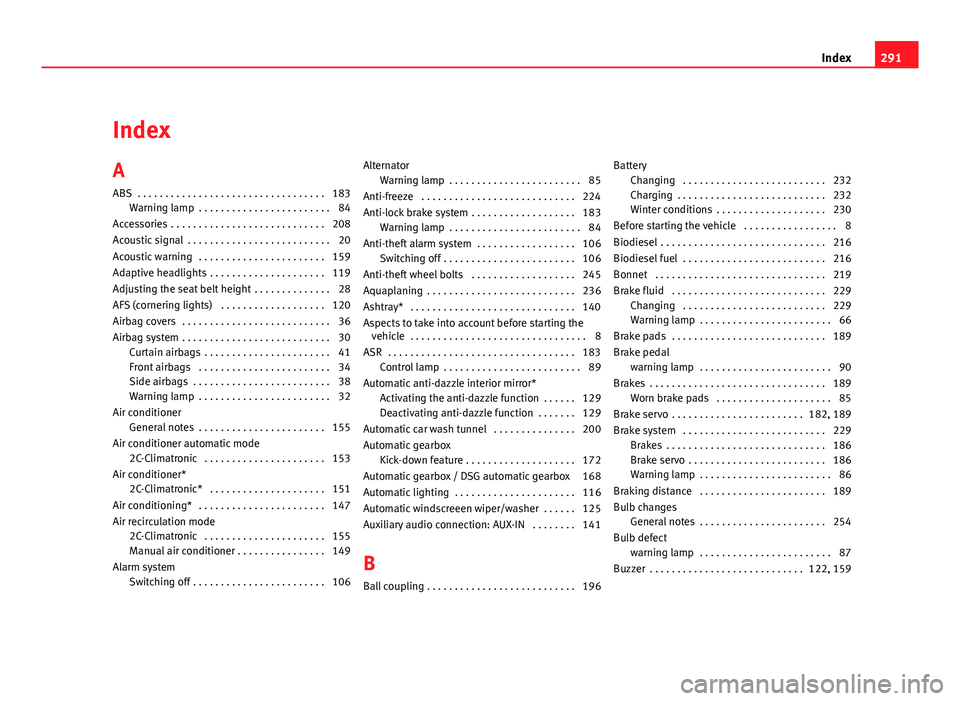
Index
A
ABS . . . . . . . . . . . . . . . . . . . . . . . . . . . . . . . . . . 183Warning lamp . . . . . . . . . . . . . . . . . . . . . . . . 84
Accessories . . . . . . . . . . . . . . . . . . . . . . . . . . . . 208
Acoustic signal . . . . . . . . . . . . . . . . . . . . . . . . . . 20
Acoustic warning . . . . . . . . . . . . . . . . . . . . . . . 159
Adaptive headlights . . . . . . . . . . . . . . . . . . . . . 119
Adjusting the seat belt height . . . . . . . . . . . . . . 28
AFS (cornering lights) . . . . . . . . . . . . . . . . . . . 120
Airbag covers . . . . . . . . . . . . . . . . . . . . . . . . . . . 36
Airbag system . . . . . . . . . . . . . . . . . . . . . . . . . . . 30 Curtain airbags . . . . . . . . . . . . . . . . . . . . . . . 41
Front airbags . . . . . . . . . . . . . . . . . . . . . . . . 34
Side airbags . . . . . . . . . . . . . . . . . . . . . . . . . 38
Warning lamp . . . . . . . . . . . . . . . . . . . . . . . . 32
Air conditioner General notes . . . . . . . . . . . . . . . . . . . . . . . 155
Air conditioner automatic mode 2C-Climatronic . . . . . . . . . . . . . . . . . . . . . . 153
Air conditioner* 2C-Climatronic* . . . . . . . . . . . . . . . . . . . . . 151
Air conditioning* . . . . . . . . . . . . . . . . . . . . . . . 147
Air recirculation mode 2C-Climatronic . . . . . . . . . . . . . . . . . . . . . . 155
Manual air conditioner . . . . . . . . . . . . . . . . 149
Alarm system Switching off . . . . . . . . . . . . . . . . . . . . . . . . 106 Alternator
Warning lamp . . . . . . . . . . . . . . . . . . . . . . . . 85
Anti-freeze . . . . . . . . . . . . . . . . . . . . . . . . . . . . 224
Anti-lock brake system . . . . . . . . . . . . . . . . . . . 183 Warning lamp . . . . . . . . . . . . . . . . . . . . . . . . 84
Anti-theft alarm system . . . . . . . . . . . . . . . . . . 106 Switching off . . . . . . . . . . . . . . . . . . . . . . . . 106
Anti-theft wheel bolts . . . . . . . . . . . . . . . . . . . 245
Aquaplaning . . . . . . . . . . . . . . . . . . . . . . . . . . . 236
Ashtray* . . . . . . . . . . . . . . . . . . . . . . . . . . . . . . 140
Aspects to take into account before starting the vehicle . . . . . . . . . . . . . . . . . . . . . . . . . . . . . . . . 8
ASR . . . . . . . . . . . . . . . . . . . . . . . . . . . . . . . . . . 183 Control lamp . . . . . . . . . . . . . . . . . . . . . . . . . 89
Automatic anti-dazzle interior mirror* Activating the anti-dazzle function . . . . . . 129
Deactivating anti-dazzle function . . . . . . . 129
Automatic car wash tunnel . . . . . . . . . . . . . . . 200
Automatic gearbox Kick-down feature . . . . . . . . . . . . . . . . . . . . 172
Automatic gearbox / DSG automatic gearbox 168
Automatic lighting . . . . . . . . . . . . . . . . . . . . . . 116
Automatic windscreeen wiper/washer . . . . . . 125
Auxiliary audio connection: AUX-IN . . . . . . . . 141
B
Ball coupling . . . . . . . . . . . . . . . . . . . . . . . . . . . 196 Battery
Changing . . . . . . . . . . . . . . . . . . . . . . . . . . 232
Charging . . . . . . . . . . . . . . . . . . . . . . . . . . . 232
Winter conditions . . . . . . . . . . . . . . . . . . . . 230
Before starting the vehicle . . . . . . . . . . . . . . . . . 8
Biodiesel . . . . . . . . . . . . . . . . . . . . . . . . . . . . . . 216
Biodiesel fuel . . . . . . . . . . . . . . . . . . . . . . . . . . 216
Bonnet . . . . . . . . . . . . . . . . . . . . . . . . . . . . . . . 219
Brake fluid . . . . . . . . . . . . . . . . . . . . . . . . . . . . 229 Changing . . . . . . . . . . . . . . . . . . . . . . . . . . 229
Warning lamp . . . . . . . . . . . . . . . . . . . . . . . . 66
Brake pads . . . . . . . . . . . . . . . . . . . . . . . . . . . . 189
Brake pedal warning lamp . . . . . . . . . . . . . . . . . . . . . . . . 90
Brakes . . . . . . . . . . . . . . . . . . . . . . . . . . . . . . . . 189 Worn brake pads . . . . . . . . . . . . . . . . . . . . . 85
Brake servo . . . . . . . . . . . . . . . . . . . . . . . . 182, 189
Brake system . . . . . . . . . . . . . . . . . . . . . . . . . . 229 Brakes . . . . . . . . . . . . . . . . . . . . . . . . . . . . . 186
Brake servo . . . . . . . . . . . . . . . . . . . . . . . . . 186
Warning lamp . . . . . . . . . . . . . . . . . . . . . . . . 86
Braking distance . . . . . . . . . . . . . . . . . . . . . . . 189
Bulb changes General notes . . . . . . . . . . . . . . . . . . . . . . . 254
Bulb defect warning lamp . . . . . . . . . . . . . . . . . . . . . . . . 87
Buzzer . . . . . . . . . . . . . . . . . . . . . . . . . . . . 122, 159
291
Index